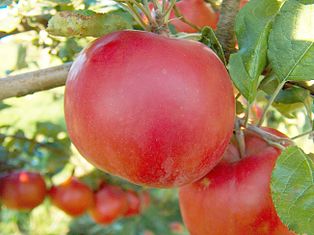McIntosh (apple)
| McIntosh | |
|---|---|

|
|
| Art | Cultivated apple ( Malus domestica ) |
| origin | Ontario , Canada |
| known since | 1796 |
| ancestry | |
| List of apple varieties | |
The McIntosh is a variety of the cultivated apple ( Malus domestica ).
history
The variety goes back to a chance seedling discovered by apple farmer John McIntosh on his farm in the hamlet of Dundela in the Canadian province of Ontario in 1796. Dundela is located in the former Dundas County , now part of Stormont, Dundas and Glengarry United Counties , near the city of Prescott . The variety came on the market from 1830, the name McIntosh came up in 1870.
Due to the short growing season and the resistance to cold, McIntosh was able to spread mainly in regions with colder continental climates such as Canada, the northeast of the USA or Poland. In the late 1990s, McIntosh was still the second most important apple species in British Columbia .
Description, harvest
The apple fruit has a yellow-green basic color, more than half of the fruit is coated in red. The soft flesh is white, very juicy and has a sweet and sour taste. The fruits are medium to large in size with an average diameter of 74 millimeters.
The McIntosh is harvested in Central Europe in mid to late September. The growing season is short and the variety is cold-resistant. McIntosh can be stored until the end of November and in a CA warehouse until the end of February.
McIntosh is highly susceptible to scab and moderately susceptible to powdery mildew . Especially in a more humid climate, the apple is very sensitive to scab, so that it is no longer planted at all in England, for example. On the other hand, it is quite resistant to fire blight .
Common mutations are 'Summerland McIntosh' from 1929 with a continuously red fruit and 'MacSpur', which is characterized primarily by its good disease resistance and winter hardiness. The compact growing, columnar mutation 'McIntosh Typ Wijcik' was the starting point for various types of slender apple trees with many very short side shoots that have been transformed into fruit skewers and carrying flower buds, the so-called columnar apple or "ballerina trees " (for example 'Bolero', 'Flamenco', ' Polka ',' Waltz ').
use
The variety is particularly popular in North American New England . The fruits are ideal for processing with applesauce , cider and apple pie .
Others
Apple's Macintosh series of computer models was named after the McIntosh apple variety - presumably by computer scientist Jef Raskin ; The different spelling may be due to an attempt to avoid confusion with McIntosh Laboratory, which is active in the audio industry .
Remarks
- ↑ a b c d e f John E. Jackson: The Biology of Apples and Pears. Cambridge University Press, 2005, ISBN 978-0521021050 , p. 42.
- ↑ Information booklet: Column apple and ballerina trees. Bavarian State Institute for Viticulture and Horticulture. From LWG.Bayern.de, accessed on August 26, 2019.
